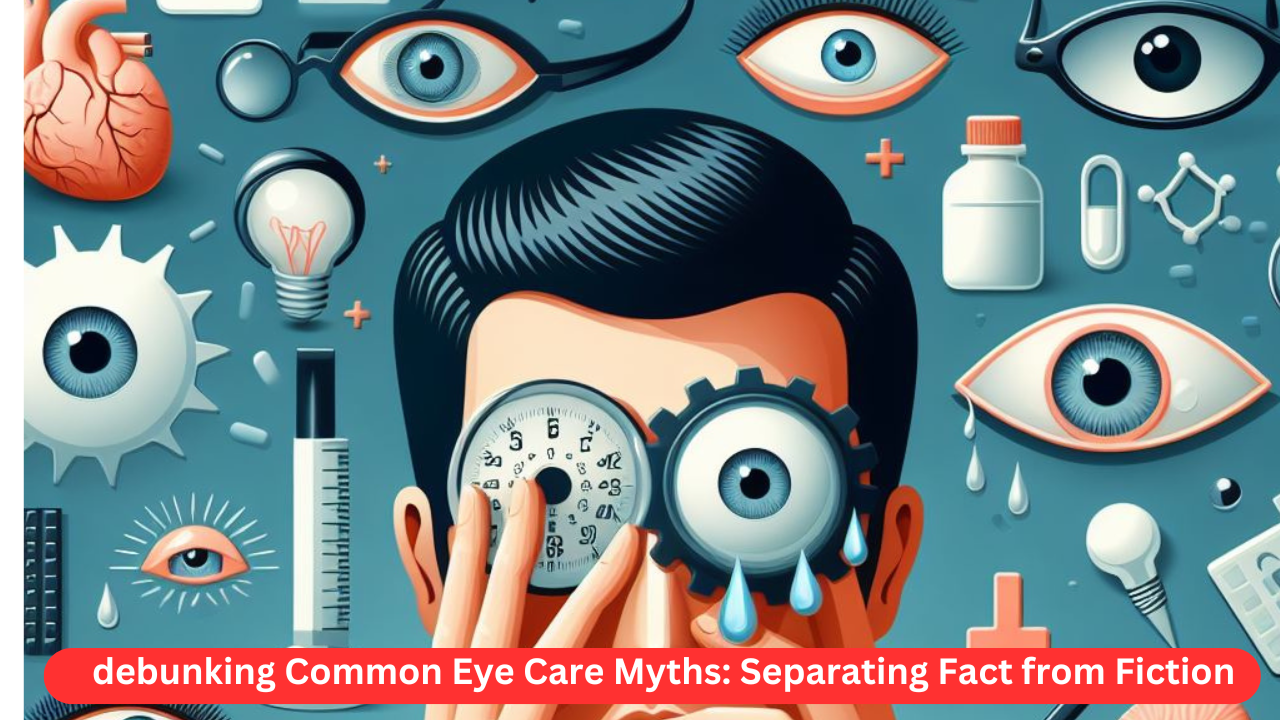Advanced Eye Care -Debunking Common Eye Care Myths: Separating Fact from Fiction
!Advanced Eye Care Myths

Introduction Advanced Eye Care
In the vast landscape of eye care, myths and misconceptions abound. These well-intentioned but misguided beliefs often lead people astray, affecting their vision and health. As responsible consumers, it’s crucial to separate fact from fiction. In this comprehensive article, we’ll explore seven common eye care myths and reveal the truth behind them. Armed with accurate knowledge, you can make informed decisions about your eye health.
Advanced Eye Care Myths
Myth 1: All Babies Are Born with Blue Eyes
Fact: While it’s true that some newborns’ eyes appear blue due to developing melanin, eye colour is not predetermined. Within about 12 months, melanin production kicks in, leading to a gradual change in eye color. So, don’t be surprised if your baby’s eyes transform from blue to brown or green as they grow1.
Myth 2: Babies Are Born with Fully-Grown Eyes
Fact: Babies are born with eyes that are approximately two-thirds of their full adult size. Eye growth continues during childhood and adolescence. So, those adorable baby eyes still have some growing to do1.
Myth 3: Two Brown-Eyed Parents Can’t Have a Blue-Eyed Child
Fact: Eye color inheritance is more complex than we think. Research suggests that up to 16 different genes influence eye color. Even parents with matching brown eyes can have a blue-eyed child. It’s all about the genetic mix1.
Myth 4: Eating Carrots Will Improve Your Vision
Fact: Carrots are rich in vitamin A, essential for eye health. However, consuming excessive carrots won’t magically enhance your vision. A balanced diet with various nutrients—like dark leafy greens, colourful vegetables, dairy, and fish—supports healthy eyesight. Remember, vitamin A alone won’t replace your glasses or contacts.
Myth 5: Eye Exercises Can Improve Vision
Fact: Unfortunately, eye exercises won’t sharpen your vision or eliminate the need for corrective lenses. Vision depends on multiple factors, and eye exercises can’t significantly alter them. However, they may help with specific conditions like convergence insufficiency.
Myth 6: Sun Gazing Is Beneficial for Health
Fact: Staring at the sun—even briefly—can permanently damage your retina and lead to blindness. Ordinary sunglasses won’t protect your eyes. Use special-purpose solar filters that meet safety standards if you want to observe the sun safely.
Advanced Eye Care
Myth 7: Crossing Your Eyes Will Make Them Stay That Way
Fact: Fear not! Your eye muscles allow you to move your eyes freely. Crossing them won’t lock them in place. So, go ahead and make funny faces without worry.

Maintaining optimal advanced eye care health is crucial, yet many people inadvertently make mistakes that compromise their vision. Let’s explore some common advanced eye care mistakes and learn how to avoid them:
- Neglecting Regular Eye Check-ups:
- Clear vision doesn’t necessarily mean healthy eyes. Glaucoma, diabetic retinopathy, and other eye problems can develop without noticeable symptoms. Regular eye exams allow for early detection and intervention, preventing up to 90% of vision loss.
- Ignoring Digital Eye Strain:
- Prolonged screen time leads to eye strain, headaches, and dry eyes. Follow the 20-20-20 rule: Every 20 minutes, take a 20-second break and focus on something 20 feet away. Blue light-filtering glasses and screen brightness adjustments also help reduce digital eye strain.
- Inadequate Protection from UV Rays:
- Sunglasses are more than a fashion statement—they’re essential for eye health. Prolonged UV exposure can cause cataracts and macular degeneration. Choose sunglasses that block 100% of UVA and UVB rays.
- Poor Contact Lens Hygiene:
- Improper care can lead to infections and corneal ulcers. Follow your eye care professional’s instructions diligently. Neglecting lens cleaning can result in discomfort and eye damage.
- Disregarding a Balanced Diet for Eye Health:
- Nutrient-rich foods like dark leafy greens, colourful vegetables, dairy, and fish support healthy eyesight. Vitamin A alone won’t replace corrective lenses.
- Rubbing Eyes Roughly:
- Our eyes can get itchy or irritated, but rubbing them aggressively can harm the delicate tissues. Be gentle and avoid unnecessary touching.
- Not Getting Adequate Sleep:
- Lack of sleep affects overall health, including eye health. Prioritize quality sleep to rejuvenate your eyes and prevent strain.

SILK Advanced Eye Care Surgery: A Paradigm Shift in Vision Correction
Now, let’s delve into the revolutionary SILK Eye Surgery. This cutting-edge procedure redefines vision correction:
Understanding SILK Eye Surgery
- What Is SILK?: Also known as Smooth Incision Lenticule Keratomileusis, SILK reshapes the cornea with unparalleled precision.
- ELITA Laser Machine: The state-of-the-art ELITA Laser Machine ensures micro-adjustments, enhancing vision correction outcomes.
- How It Differs: Unlike traditional LASIK, SILK creates a lenticule within the cornea using a laser, minimizing surgical invasion and potentially reducing complications.
- Precision and Effectiveness: SILK promises precision and effectiveness, ushering in a new era of efficiency and innovation in vision care.
Benefits of Choosing SILK Eye Surgery
- Immediate Recovery: SILK offers impressive recovery speed, allowing you to resume daily activities swiftly.
- Minimal Invasiveness: With smaller incisions, SILK minimizes discomfort and post-surgical complications.
- Enhanced Precision: SILK’s advanced technology ensures precise vision correction.
- Flawless Results: SILK isn’t just a procedure; it’s a promise of optimal outcomes for your eyes.
FAQs about the SILK Procedure
- Is SILK suitable for everyone? SILK is best suited for specific refractive errors. Consult an ophthalmologist to determine if it’s right for you.
- Does SILK hurt? SILK is virtually painless, and most patients experience minimal discomfort.
- How long does recovery take? Recovery varies, but many patients resume normal activities within a day or two.
Advanced Eye Care
By avoiding these common advanced eye care mistakes and adopting healthy habits, you invest in a brighter and clearer future. Remember, the path to healthy eyes is paved with regular checkups, mindful digital practices, UV protection measures, proper lens cleaning, a nutrient-rich diet, gentle care, and quality sleep.
Consult your eye care specialist before using any treatment medicine or exercise.
More Interesting Articles
6 signs of heart attack a month before
Average steps per day- Unlocking the Power of Steps: How Walking Can Transform Your Health
Nutrient Dense foods- Understanding Vitamin D: The Sunshine
The Healing Elixir – Lukewarm Water: Eight Benefits of Drinking Lukewarm Water Every
Nicotine Free Vape vs. Vaping vs. Smoking: Unraveling the Health Conundrum
Yes ! Feeding Your Mind: The MIND Diet’s Recipe for Brain Health
Does Intermittent Fasting 16/8 Raise the Risk of Heart Disease-Related Death?
The Reckless Overuse of Antibiotics: A Worldwide Health Emergency
Deaths Linked to pregabalin side effects Have Surged in The UK
The Hidden Dangers of Ultra Processed Foods list: A Wake-Up Call for Our Health
The Benefits of Eating Raw Onion: A Nutritional Powerhouse
Healthy Diet Menu -The Foundation: A Heart-Healthy Diet
International Women’s Day 2024- 7 Critical Health Concerns Every Woman Should Prioritize
Unlocking Heart Health: Discovering Hope “can atrial fibrillation be cured”- A Holistic Approach
India’s Public Health Quandary: Balancing Prosperity and Wellness
The Future of Food Allergy Management: New Technologies and Treatments
Huge Genome Study Addresses Race Analysis Concerns and Expands Global Insights
Dhyanabindu Upanishad- Journey Towards Spiritual Enlightenment: A Comprehensive CommentaryEdit
Discover more from News 24 Media
Subscribe to get the latest posts to your email.


